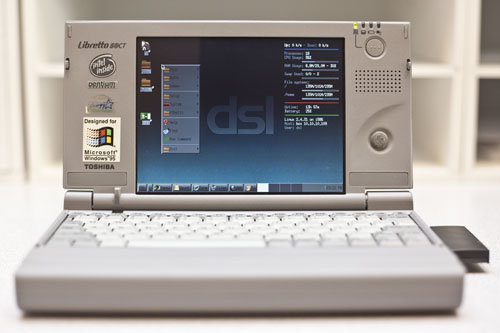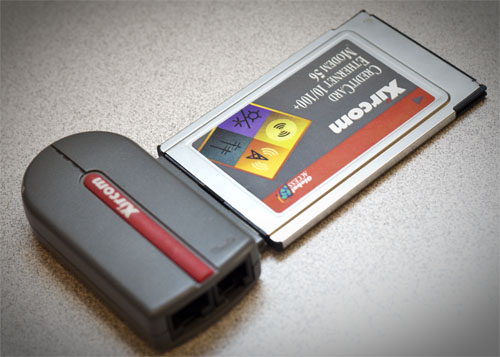
I’ve been trying to get some version of Linux on my Libretto 50CT for quite some time now. One of my conditions for this is that I wanted it to run off of a compactflash card instead of the clunky old 800MB hard drive that originally came in the Libretto. There is a problem with this though. I’ve been running into a wall trying to use a 4GB CF card because of LBA mode or some other layer of translation. For some reason, fdisk can’t come to grips with this. Most reasonable Linux distributions need at least a gig of disk space but I searched out one that did not…. Damn Small Linux.
DSL only needs 200mb minimum which is perfect since I happen to have a 256mb CF card laying around. I popped it into my Pentium 133 desktop system with a CF-IDE adapter. I went into the BIOS to make sure to auto-detect the card in “NORMAL” mode instead of “LARGE” or “LBA” modes. Then I used a Redhat Linux 5.0 disk I had laying around to fdisk the partition. I created one big partition that took all of the space, made it bootable and saved/quit.
After that, I popped in the DSL 4.1.10 ISO-LINUX live CD. It booted up into the gui and I ran:
sudo /usr/sbin/dsl-hdinstall
I made sure to run that from a black xterm so I could see the text. At the end, when it said it wanted to reboot to finish the setup, I stopped the computer and popped the CF card into my Libretto and booted it up there.
It booted up just fine but when it got to X it was REALLY ugly and the mouse didn’t work. I hit “ctrl-alt-del” to pop out of X. At the prompt I ran:
xsetup.sh
I made the following choices:
- Xvesa
- no USB mouse
- no mouse wheel
- ps2 mouse
- 2 buttons
- 640×480 pixel
- 16-bit color depth
- no “choose own dpi”
- us keyboard
After all that, I restarted X and it appeared picture perfect with a functioning mouse.
Next priority was network access so I popped in a Xircom card I’ve been toting around forever.

There is a nice control panel in DSL that allowed me to configure it pretty quickly.
Next was wireless access but the problem is that there is no support for WPA in the 2.4 kernel or in any 16-bit PCMCIA cards that will actually work in this laptop. Luckily there were quite a few 16-bit PCMCIA wireless cards available. I have a few but I happened to chose an Orinoco Gold Wireless PC Card since it’s a nice robust card and I have a couple laying around.
Being a security-minded individual, the best solution I can think of is implementing a wireless network with the following parameters:
- a hidden essid
- MAC filtering
- WEP
- 802.11B only
- attached to my outside DMZ
Beyond that, I’m at a bit of a loss. It’s still a WEP network afterall and there is only so much that can be done to secure it. But alas, I snagged on of my extra WRT54G’s and configured it with those parameters in mind and everything is pretty much up and running flawlessly. Time to rebuild another battery I guess 🙂
If you like the content on this site, please support it by using this link to order from Amazon. You know you were going to go there and buy stuff anyhow so why not help me pay the hosting bill.


Here’s another good thing to do with this setup in particular:
http://www.damnsmalllinux.org/wiki/index.php/ReducingMemoryUsage
If you do nothing else, at least comment out the virtual terminals. The savings is huge.
Just a quick question.
I saw that you installed Gentoo on your Libby 110, just curious, why didn’t you opt for that on this (the 50) system as well? does gentoo run more things at start up than DSL? I tried DSL on my 110 but was bummed out about no WPA authentication. I tried several other distros but I’m a total newb and couldn’t figure out how to get my wifi card working and connected with the tools that were included in those distros.
Keep posting your Libretto adventures as they happen!
There are a couple of problems with putting Gentoo on the 50ct. First off, gentoo is source-based so it compiles everything as you put it on there. This takes a while on the 110 as you can imagine but would take eons on the 50ct. The bigger problem is that the 50ct can only take up to 32mb of ram. This really isn’t enough to run Gentoo effectively from what I can tell.
In all honestly, I’ve come to love the 50ct as a MS-DOS machine. It is a very FAST MS-DOS machine since DOS was already being phased out by the time the 50ct was released. It runs most of the games I’ve thrown at it without a lick of trouble. Of course most of the games are ones off of . That being said, I chucked a 4gb CF card in place of the hard drive so I can pop the card out any time I want to and add more games from a more capable computer.
There is another LARGE problem with getting WPA support on the Libretto 50ct… The 50ct has a 16-bit PCMCIA card slot as opposed to a 32-bit cardbus slot. To my knowledge, there has never been a 16-bit wifi card with WPA support. I think that is the main problem you are running into with WPA opposed to the OS/Drivers not supporting it. It’s a hardware thing really.
This is what I do… I have a whole separate router that uses WEP, MAC address filtering, invisible SSID and it’s hooked to a DMZ vlan so it cannot access any of my internal network resources. Obviously that is not a portable solution but if you are going somewhere public, the wifi is typically open without WEP anyhow.
If you want a more capable Libretto that can do modern things, I’d suggest springing for a Libretto 110CT. It’s no speed demon but it does have 2x 32-bit PCMCIA cardbus slots at least which opens up far more options and a slightly larger screen. Honestly I prefer the 50ct for MS-DOS though because it has a 4:3 640×480 screen which is much more agreeable with DOS applications.
I see, I hadn’t thought about the resources Gentoo would need to install. That explains it.
Re: the card bus thing. I didn’t know the 50 had a 16bit slot. I’ve played around with HP Jornada’s and the 16-bit pcmcia slot was a problem for trying to get it to work on a modern (wpa) network along with the fact that CE never supported it. Although I think the Cisco Aironet 350 card might fit the bill for Linux. (http://www.cisco.com/en/US/prod/collateral/wireless/ps6442/ps4555/ps448/product_data_sheet09186a0080088828.html ) (it’s just a hunch, but maybe?)
I gave up on the linux angle (on my 110) and loaded XP on an SSD with a lot of services disabled and it seems to run semi ok. I need to get a second one and learn linux on it so I can make a leaner more capable system out of them.